The Best Food and Beer of Belgium: 15 Things You Should Taste

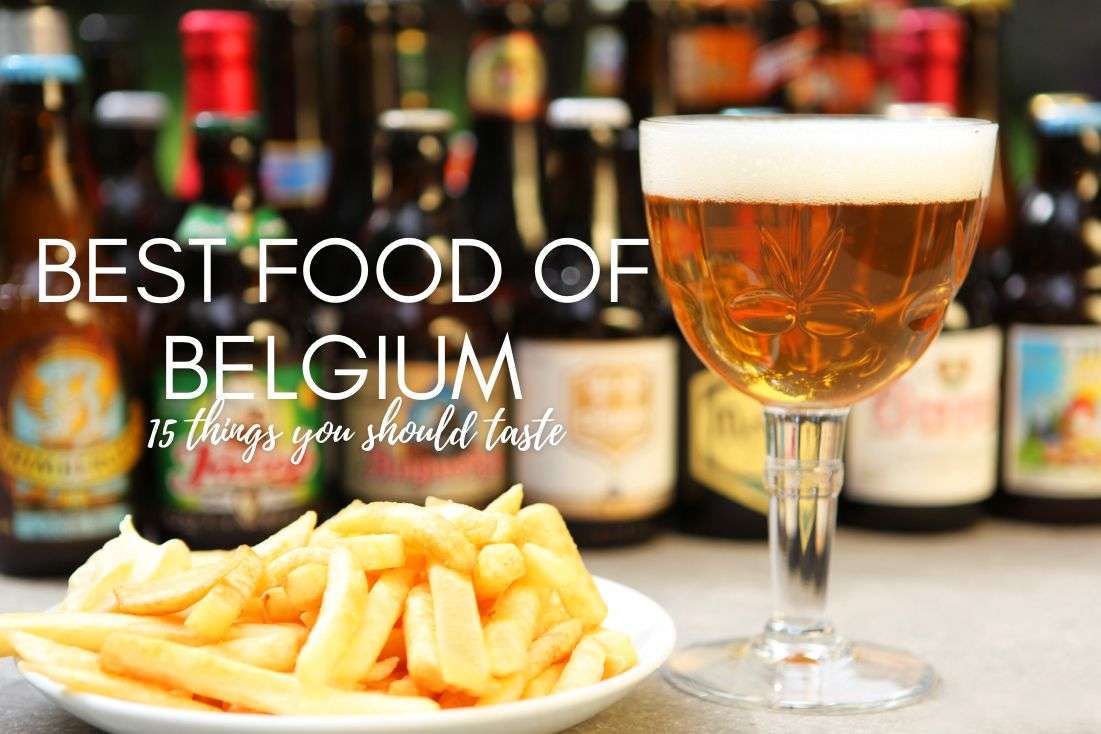
While Belgium itself may have been overshadowed by its more well-known neighbors, the country's cuisine is more than enough to entice any foodie to make the trip.
Belgium has gained notoriety for its fast food, but its cuisine is much more than that; it is an exquisite fusion of the culinary traditions of France, Germany, and the Netherlands.
What do you imagine when Belgian cuisine is mentioned? Probably chocolate and waffles? Fries? If you are a beer lover like me and Karin, maybe the world-famous Kriek or Biere blanche will come to mind.
All this is absolutely true and fair, but Belgian cuisine has much more to offer. We witnessed this firsthand and would like to share our knowledge and tell you about the best Belgian foods. For us, Belgium was one of our favorite countries for food!
Tip: If you’re in the planning stages of your Belgium trip, head on over to the end of this article for some of our hotel tips and further reading.
You might also be interested in reading:
- Belgium Itinerary: 7 Days in the Heart of Europe!
- Belgium Travel Tips: 19 Things That Will Make Your Trip Easier
- The Top 15 Museums in Belgium: From Comics to Beer
- Our 9 Top Restaurants in Belgium
- 7 Best Day Trips from Brussels (Includes Train Details)
Belgian food
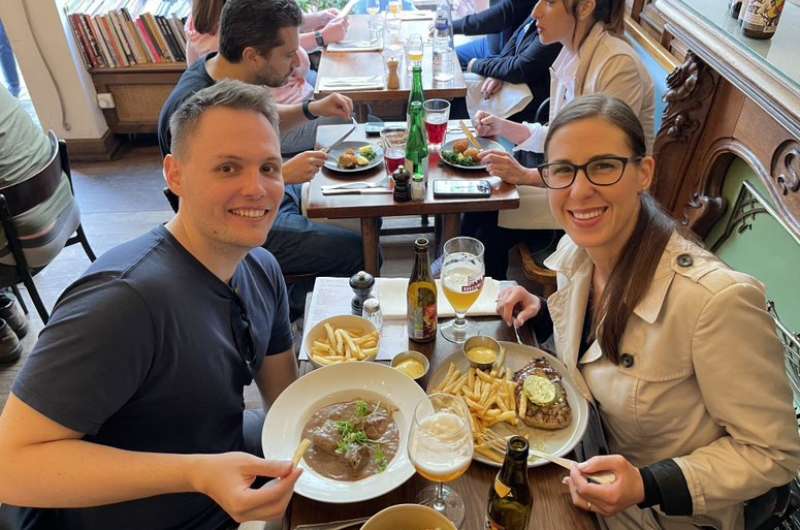
Belgian food making us smile @ Nüetnigenoug in Brussels
The culture of Belgium places a significant emphasis on its culinary traditions. We thought the food in Belgium was great, though there is a lot of fried stuff, and it’s not going to do much for your diet.
In the same way that the country is split apart linguistically, it is also split apart when it comes to the kinds of cuisines that people prefer to consume. For example, while Flemish cuisine is heavily influenced by Dutch cooking, Wallonian cooking is quite similar to French cooking and makes extensive use of various kinds of sauces.
Belgian beer
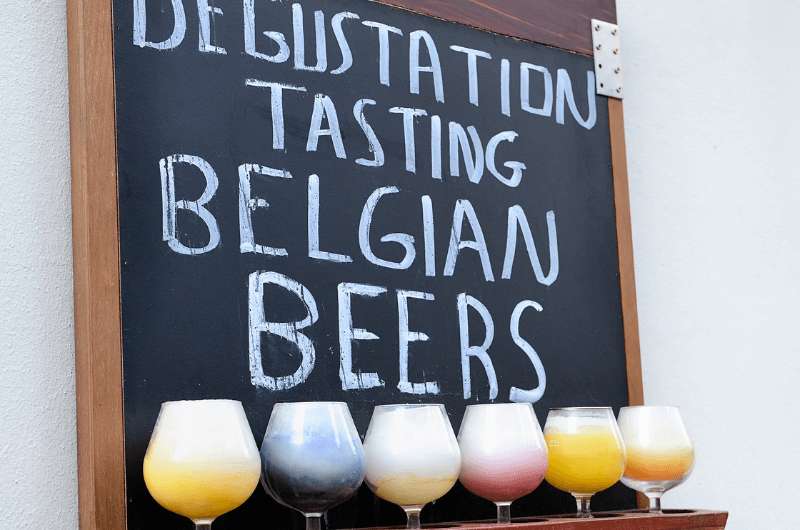
You’ll be spoiled for choice when it comes to beer in Belgium. A degustation can help you figure out what you like.
Beer is not a food, but come on, this is Belgium we’re talking about! It’s a staple!
As you know, Karin and I are big connoisseurs of beer. As Czechs, we have every right to be skeptical of beers from other countries. That said, we aren’t beer Nazis and accept a wide range of tastes. You can’t go too wrong with beer.
Except for the ones in Peru. That was rough. There was literally one restaurant (in Machu Picchu) that saved Peru’s beer-making reputation. But it’s hanging by a hair.
Belgian beer, on the other hand, is spectacular and really struck a chord with us. So our first three top foods in Belgium are beers! You’re welcome.
Tip: You’ll gain even more appreciation for Belgian beer (and beer overall) if you educate yourself on the subject. We were fascinated by the information at the Bruges Beer Experience, a museum that topped our list of the best museums in Belgium!
1. Wheat beer—the hazy one
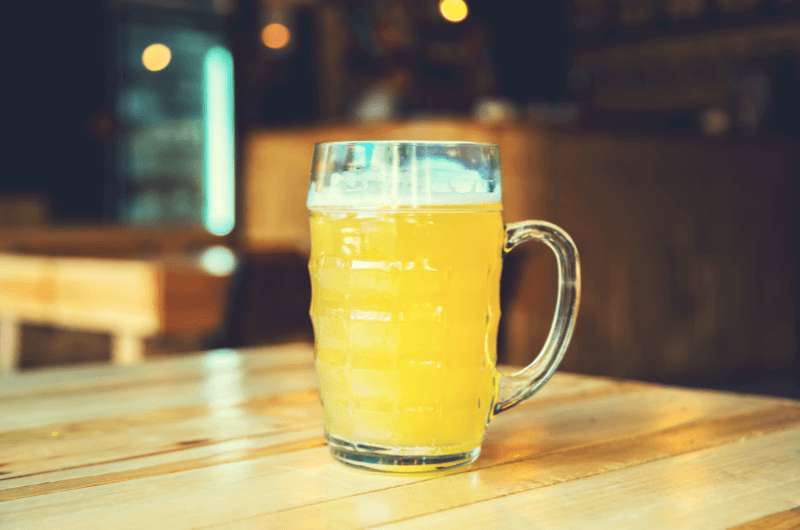
One witbier, sir
Witbier (as Belgians call it), also known as white beer, is made with raw (unmalted) wheat, and sometimes oats and malted barley. The wheat proteins make the beer look white and hazy, hence the name. The suspended yeast that is added causes the fermentation to continue in the bottle.
It also contains hops and spices for flavor—most often coriander and orange peel. Sounds exotic, doesn't it? Wheat beer still has a mild sour taste, which might be why the spices started to get added in the first place.
A wheat beer that is trendy these days, Hoegaarden, has actually been around since the 16th century. Peter Celis, who revived the Hoegaarden brand in Belgium in the 1960s, then moved to Texas in the USA to start Celis Brewery. He’s also the guy that started adding the spices into witbier.
2. Lambic beer—the wild one
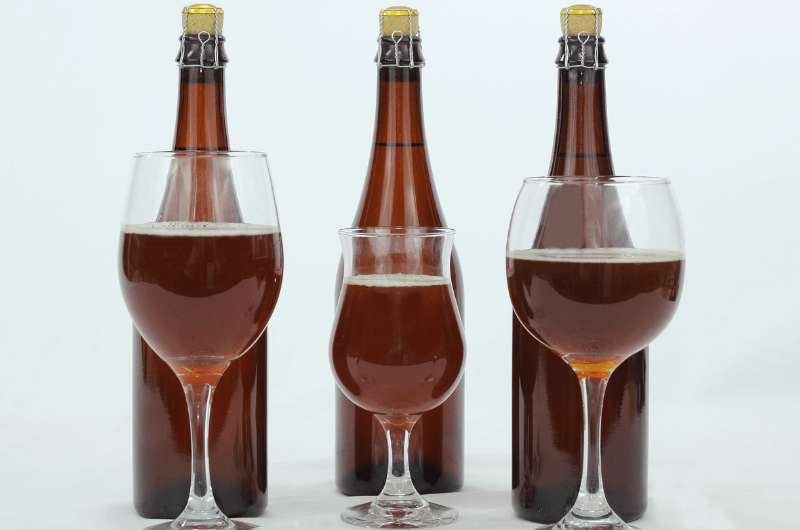
Copper-colored beer=lambic
Another beer, another color. Lambic is one of the oldest types of beer in Belgium and has a rose or copper color. Since the 13th century, Lambic beer has been brewed in the Pajottenland region of Belgium, which is southwest of Brussels, and in Brussels itself. In places like the US, however, it’s a very new type of beer. You might even call it trendy.
Lambic is a flat beer that is fermented by wild yeasts and bacteria from the Senne Valley instead of strains of brewer's yeast that have been grown in a lab. If you like your beer to taste like a barnyard crossed with the dirt from the cellar floor with a hint of fruitiness, lambic is for you.
Several kinds of lambic beer exist. My favorite was gueuze (blend of young and old lambics), but Karin didn’t like its hoppy taste. She preferred kriek (fermented with cherries) and framboise (fermented with raspberry).
Our top tips about food in Belgium:
- If you don’t know which beer to choose in a bar or restaurant, ask for a degustation. They’ll bring you some small glasses to taste.
- Try Andalouse dip or mayonnaise for french fries. Pardon, me, Belgian fries.
- Avoid eating beef tartare if you are pregnant or sick.
- Pâté and chocolates make cool souvenirs from Belgium!
3. Stout beer—the naughty one
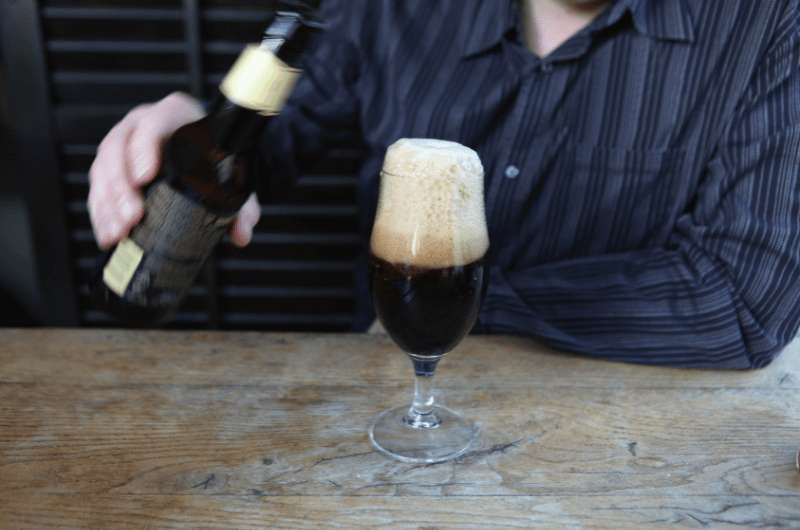
Tip: Pair your stout with some chocolate cake!
Stout is a peculiar beer in that there are so many variations, not even beer pros can always agree on whether something is or isn’t a stout. In beer competitions, there is never a category for stout. Sometimes, any dark beer is mistakenly called a stout.
Historically, the term stout was used for any beer that had a high alcohol percentage. Nowadays, let’s be content with the conclusion that stout has to be made with unmalted roasted barley and is always dark. But it can be sweeter or smoother or dryer depending on other ingredients and their amounts added.
Stout will usually taste chocolate-y or coffee-y. Some might even say it tastes naughty (because the Flemish word “stout” means just that).
Tip: If you don’t know which beer to choose, feel free to ask for degustation. They might give you different kinds of beer in small glasses, so that you can choose your favorite one.
You are probably wondering where would be the best place to drink beer in Belgium. We have prepared an article about the best restaurants in Ghent, Brussels, and Burges.
And as a special tip, know that you can take a tour through an actual brewery in Bruges, De Halve Maan Brewery. Not only do you witness the production of beer, but you also see great views of the city from the rooftop bar. And there is one type of unfiltered beer that you can only buy directly at the brewery—Brugse Zot. More on our experience there in our Bruges guide.
4. Belgian fries (not French fries!)
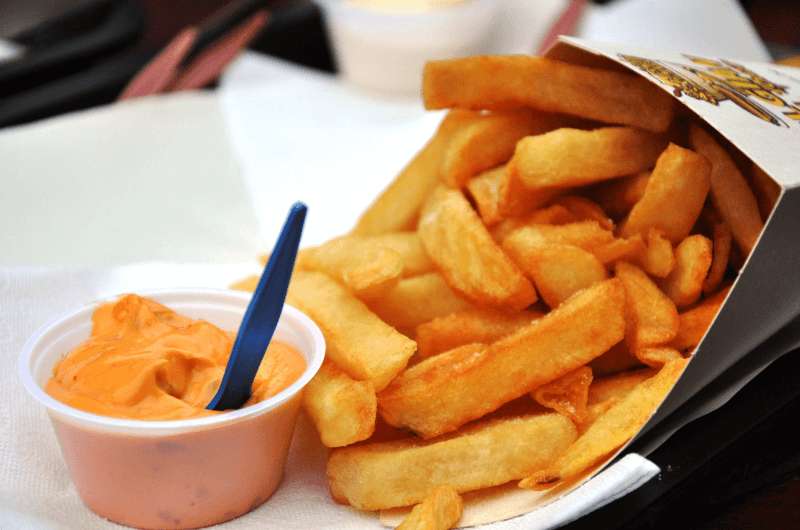
Can’t choose between may and ketchup? Andalouse sauce is kind of like a combination of the two
These are the best fries we've ever had. NOTE: In Belgium, the phrase "French fries" is not used. Belgians may get irritated by it. You can guess why. Belgians say frieten (in Flemish) or frites (in French).
Whatever you call them, they need no introduction. Fries are fried potato strips, and in Belgium, they come with just about anything.
What distinguishes the Belgian variety is that they are cut fatter and that they are double-fried, resulting in a crispy exterior and a soft inside. The first frying is meant to cook them, the second, done right before serving, is to add color and crunch.
So why are they called French fries? Some sources say it is because of a mistake. During WWI, American soldiers stationed in Belgium recognized the French language being spoken all around them and assumed they must be in France. When they tasted and fell in love with the now-world-famous fried potato treat, they named it French fries. Oops.
Tip: If you veer off the more beaten Belgian track, aka Flanders, and head down south to Wallonia, you can try eating fries while listening to people talk around you and try to understand the innocent mistake. Check out our article about the top places to visit in Belgium. Meuse Valley, along with cute Dinant town, could be the area where fries originated... if you believe the stories!
But nobody can prove this theory, and it isn’t the only one in existence. This article talks about more possible origins of the humble fry, check it out if you want to join the debate. Are you team Belgium, or team France?
Or can we all agree on calling it the Francophone fry, as one of the chefs and researchers in the article suggests?
Putting the past away, we can all agree that Belgian fries are fantastic. A cultural quirk of Belgians is that they prefer to dip it in mayonnaise rather than ketchup. Andalouse sauce, a mix of mayonnaise, tomato paste, and peppers, is another favorite.
5. Beef or steak tartare
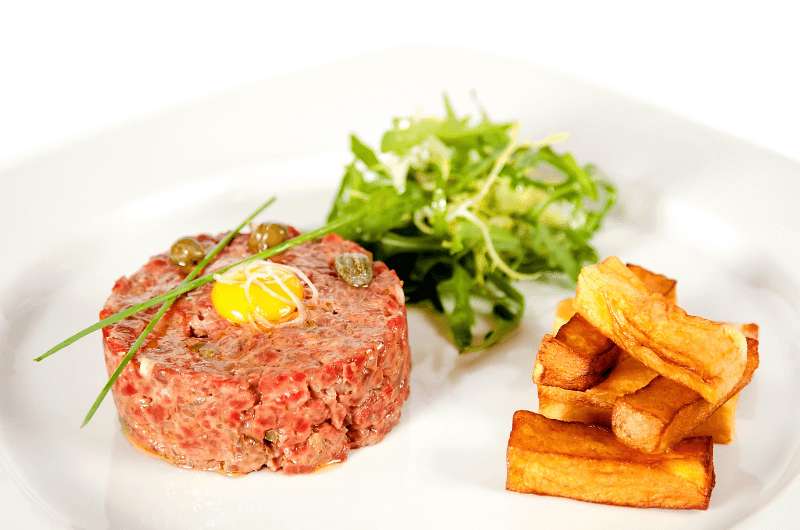
Fries come with every food in Belgium
Don't get your hopes up for a delicious steak if you place this order. This dish consists of raw minced beef that has been seasoned and served cold.
The meat, which should be high quality and lean), is flavored with a variety of ingredients. Raw or pickled shallots, egg yolks, capers, mustard, Tabasco sauce, parsley, salt and pepper are all examples of typical seasonings.
Beef tartare is served as a round mound of the raw beef with the spices already mixed in. A common side to beef tartare are (Belgian!) fries and, of course, an always-necessary beer.
If you get a toast kannibaal, you’ll get your tartare on or with some bread.
6. Belgian chocolate and pralines
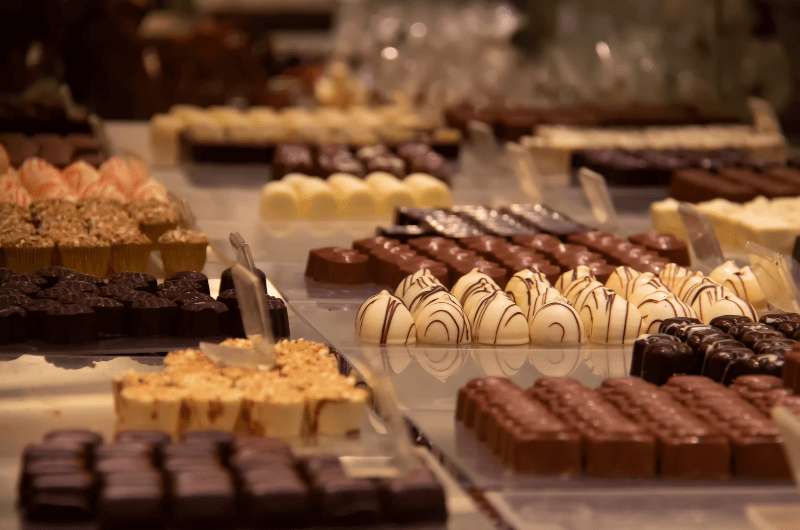
Pralines come in all shapes and not many sizes, but they’re all supposed to contain nuts of some sort
Chocolate has been a major industry in Belgium since the 19th century, and has had some association with it some 200 years before that, when Belgium was occupied by Spain, who brought it over from South America.
The funny thing is that even though Belgian chocolate is world-renowned, there is no actual standard for what can and can’t be called Belgian chocolate aside from the fact that it has to be produced in the country. So I suspect the quality varies widely.
The praline is an original Belgian chocolate invention. Pralines are small chocolate confections that, according to the definition, must contain at least nuts, though a cream filling is also very common.
Chocolate, much like beer, is served in or with almost everything you order in Belgian restaurants, so if you like the sweet goodness of it, you’ll love Belgium. We discovered that Belgians consume a lot of chocolate... A LOT.
There are over 2000 chocolate producers in Belgium. Côte d'Or is the largest commercial company, but Godiva and Leonidas might also ring a bell unless you live under a rock.
7. Moules frites
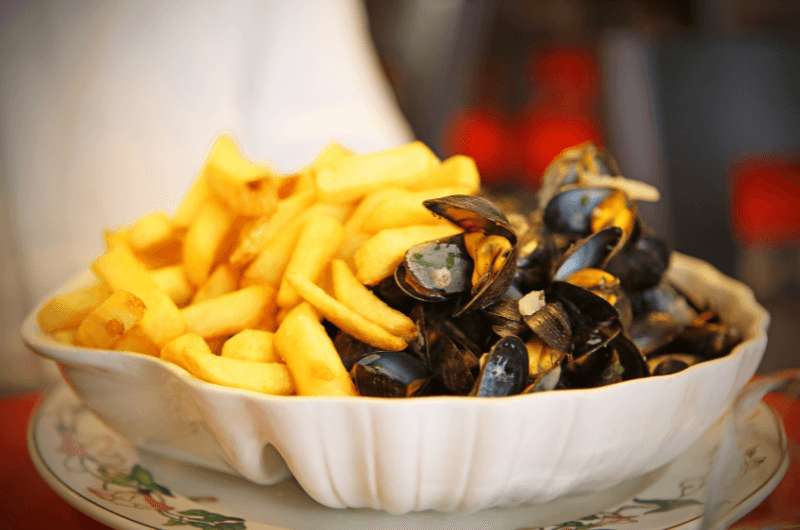
I hate 50% of the things on this plate
If it were up to me, I’d say stay away from moules frites, because I absolutely hate mussels. But if I let on that I’m not able to speak for everyone else on the planet, I, like any good husband, asked my wife for my opinion instead.
And since Karin loves mussels, I can put moules frites on this list of the best food in Belgium. See how that worked out?
Based on the annual consumption of mussels in Belgium—an estimated 30 million tons, or 3 kg per person—it seems Belgians agree with Karin rather than with me.
Moules frites is the Belgian national dish. It’s a very popular meal eaten year-round nowadays, though mussel season in Belgium is July through April. Outside of this time you’re probably eating Danish mussels which are known to be not as delicious.
Moules frites are traditionally prepared in a white wine sauce with shallots, parsley, and butter (la marinere), but there are now a million different varieties for all tastes. Some recipes call for Belgian beer instead of wine, while others call for cream or vegetable stock in place of wine.
8. Belgian waffles
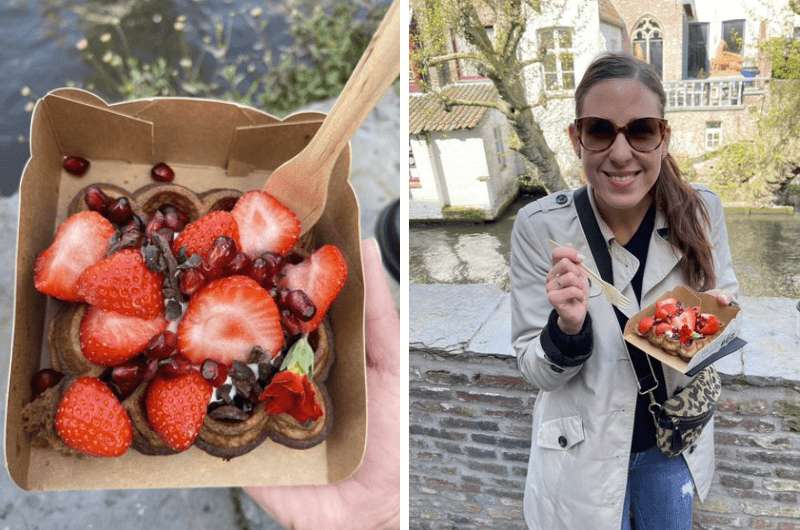
You can’t go wrong with strawberries!
I don't think it's necessary to point out that waffles are a significant part of the culture of Belgium. They are offered in virtually every eatery. Though that sounds great, it’s important to note that they are mostly shit quality. Check online reviews of places if you really want the real deal.
We loved the waffles at Otto Waffle Atelier in Bruges, Bridge in Ghent, and Maison Dandoy on Grand Place in Brussels.
There are, in general, two types of waffles in Belgium. Liege waffles come without toppings, are oval in shape, and are dense and sweet. You eat them with your hands. Brussels waffles are rectangular, come with everything from fruit to chocolate to whipped cream, and are wonderfully fluffy on the inside and a little crunchy on the outside. They taste like heaven.
9. Meatballs with tomato—or other— sauce
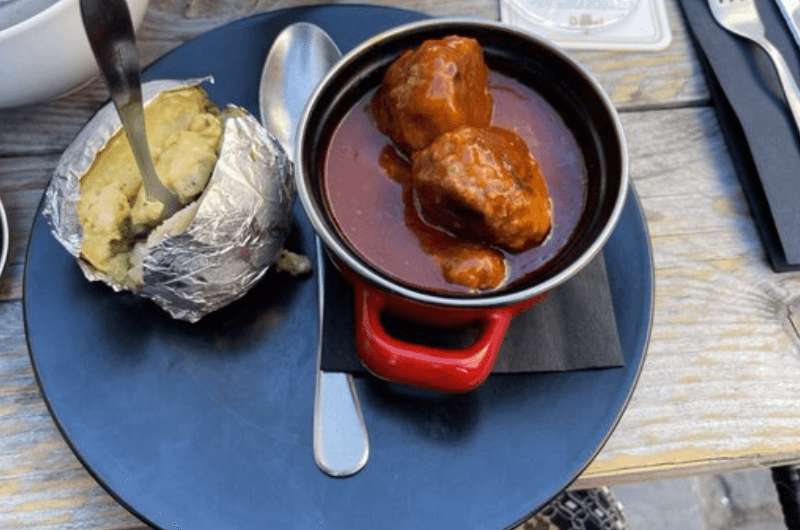
My two meatballs came with a baked potato, but trust me, you can get them with fries, too
Belgians really like their meatballs (boulets), though what you’ll typically get them served with depends on which part of the country you're in. They are usually made of half pork and half beef.
In Flanders (northern Belgium), tomato sauce is most popular, with fries on the side. And a beer. Alternatively, they come fried in butter and served with a cherry sauce. Decidedly lovely. We vote for the tomato sauce and beer.
In Wallonia (southern Belgium), they are usually served with mixture of beef stock and fruit syrup. They frown upon the tomato sauce variant. I frown upon them.
A grandma’s tip is that the second day after cooking the meatballs, they are even more flavorful and filling. This is the kind of comfort food that Belgian moms make for their children.
10. Flemish beef stew
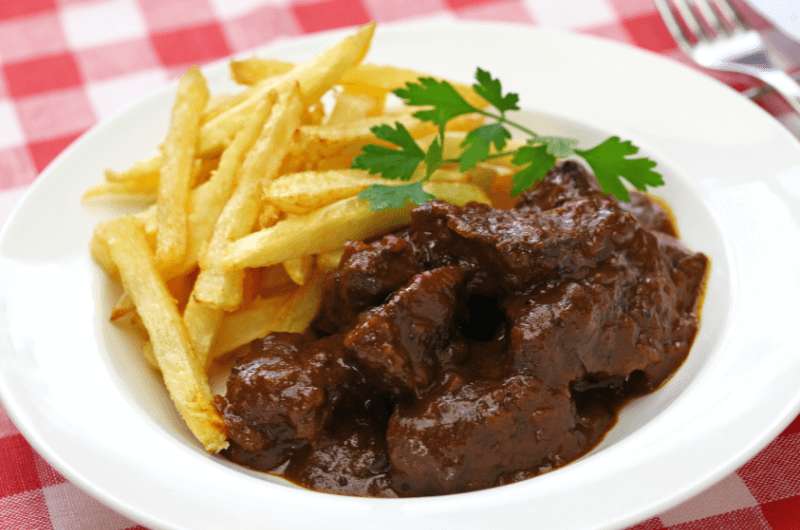
I’m not mad at it... it’s just not my favorite. But I have very high standards.
In most cases, wine is used to produce beef stews or beef bourguignon; however, Belgians typically combine the wine with another ingredient. Can you guess it... BEER? Correct answer!
This Belgian meal didn’t make me fall in love, probably because I am Czech and have tasted many a wonderful goulash in my days, so the comparison creeps in. I think Flemish beef stew can’t hold a candle to goulash, even with the addition with wonderful Belgian beer.
The stew also contains thyme, berries and mustard.
As is standard in Belgium, you have to pair your stew with the right type of beer to really bring out the taste. Your server will be happy to help you with your choice.
11. Croquettes
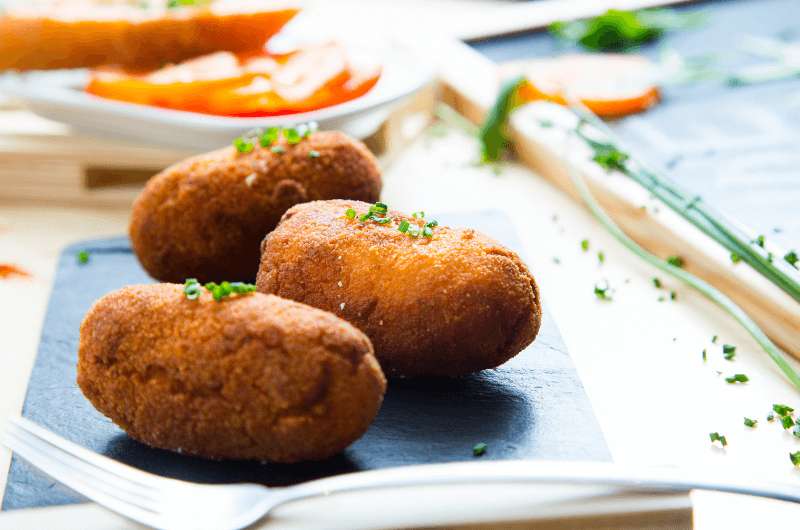
If these are cheesy, I’m sold
In Belgium, croquettes—or kroketten—are a very well-liked starter dish, but you can also eat them as a main meal, obviously combined with fries and maybe a small salad.
They are balls or cylinders made out of a batter, breaded and deep fried.
Historically, croquettes were made out of just mashed potatoes, but nowadays, there are so many varieties that there are restaurants that serve just the fried goodness and nothing else. Except for beer. There’s always beer. No need to panic.
The most popular types are shrimp and bechamel, and cheese.
The cheese balls are without a doubt our top pick in this category. Croquettes like these are typically served with a variety of sauces. You just better not be trying to fit into last year’s swimming suit anytime soon after indulging in them.
12. Shrimp-stuffed tomatoes
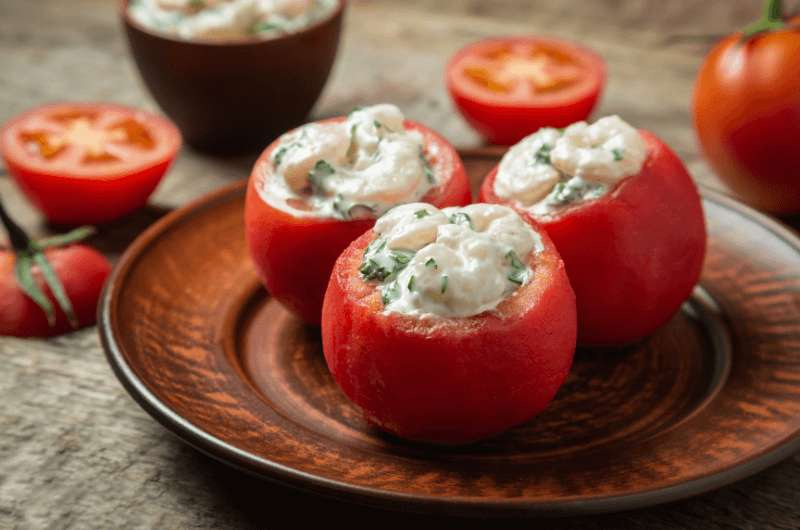
These guys are missing their “hats” made out of the piece that was cut off
Tomate crevette is a juicy and delicious Belgian food. Small brown shrimps, sometimes called the "caviar of the North Sea," are used to create a sort of salad with a bit of mayo and lemon juice, which is then stuffed inside a juicy tomato.
Considering the very small ingredient count, everything has to be in the best quality in order for this dish to turn out great. But when it works, it works. I just know I wouldn’t want to be the person peeling those tiny shrimps!
13. Asparagus aka white gold
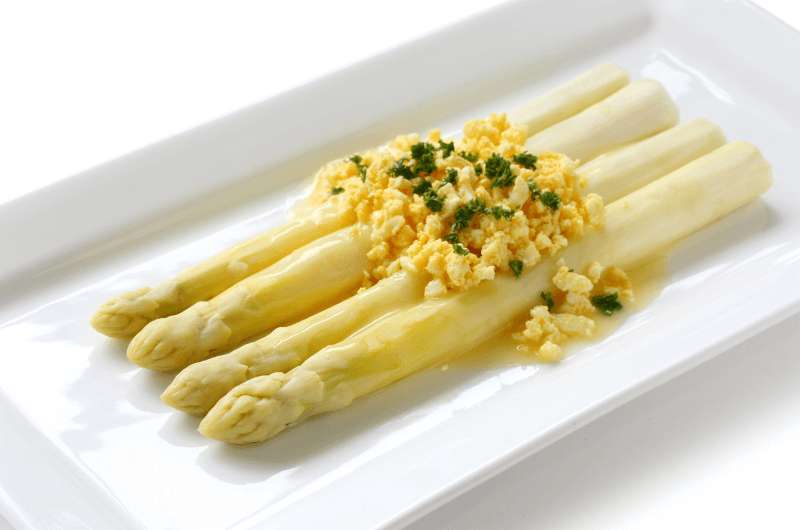
Get your serving of white gold between April and June
In Belgium, the asparagus season is from late April to early June. What that means is that during this time, you’ll notice asparagus on absolutely every menu. Asparagus season is short guys, they have to make the most of it! It’s also why it’s nicknamed “white gold”.
We were lucky enough to be there during that time.
The traditional Flemish asparagus is a starter consisting of sticks of white asparagus with chopped or mashed hard-boiled eggs on top with a bit of parsley for color.
Of course, had they not grown the asparagus under a layer of soil, it would’ve had its typical green color. The reason they prevent photosynthesis, and therefore any color, is that the white asparagus is more tender and sweeter than the green kind.
14. Pâtés
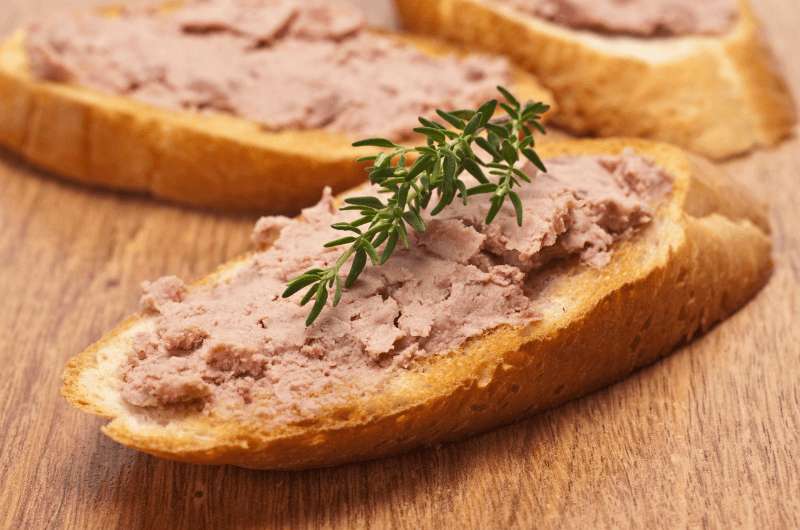
Eat your paté on toasted bread or crackers
Belgian pâté is perhaps the most "homemade" of all national dishes, recipes for which have been passed down from generation to generation. To be clear, a paté in Belgium will usually be made of pork liver with some additional ingredients and spices whose combinations make up a wide variety of tastes.
They taste just as good as French pâtés, in my humble opinion. You have to try beer paté. I know I’m lame with all the beer love in this article, but this paté was top notch!
It was interesting to note that most of the companies involved in the production of this Belgian delicacy are family businesses.
These small businesses pay special attention to the quality of the product, while using only fresh (not frozen) meat and high quality fruits and spices.
Also, they don’t add any sugar, because it would change the original taste of the product. Packaging is often hand-decorated, which is cute and the reason why I think a little paté could make a great souvenir to bring home.
15. Crème brûlée
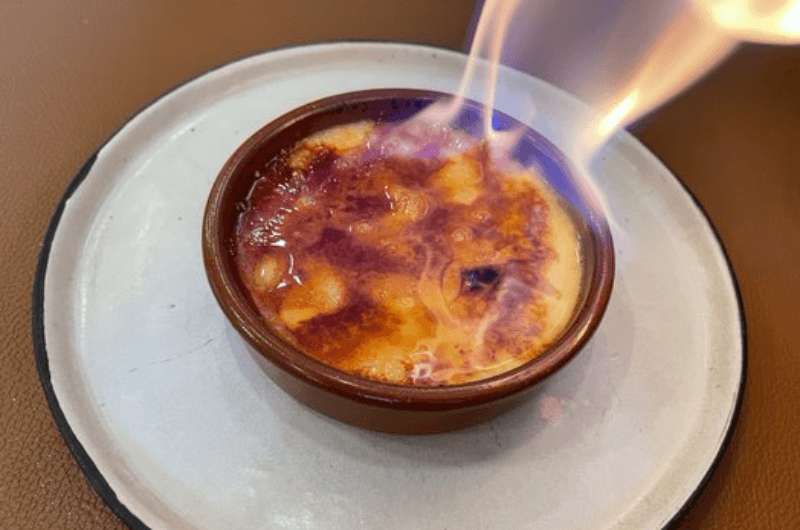
Can I get some fries and a beer with that?
A popular dessert consisting of a rich custard base topped with a layer of caramelized sugar. The entire thing is chilled, so that the flame hardens and warms the top, the center stays cool. However, the Belgian guys stepped up and often pair it with chocolate. Who could resist?!
This is another instance of fighting for the origination credit with France, just like with French fries. This time though, I think it’s Spain that dominates, with their crema catalana being virtually identical and dating back to the 14th century, about 300 years prior to the first mention of a crème brûlée in any type of cookbook in Europe.
There you have it. You can see that a gastro trip to Belgium will leave you full, fat, and happy. What more could you want?
Further planning and hotels
Don’t forget we have articles about each city’s top things to see and do: Brussels, Ghent, Bruges. We even have a detailed itinerary for Brussels. Or, read up on day trips from Brussels if you have some more time on your hands. Luxembourg, anyone?
Oh, you want to sleep in Belgium, too? We have some tips for you on places to stay in Belgium. So, um, can we ask a favor? If you book a hotel in Belgium (or anywhere else) through our booking.com affiliate links, we’ll get a small (like, really small) commission at no extra cost to you. Thank you so much!
Here are a few hotel tips that we’ve hand-picked for you for Brussels, Ghent and Bruges. But you don’t need to book these specific places for us to get a small kickback. Again, much appreciated!
Hotel in Brussels
The cool and comfortable Radisson Red
Halfway between the Royal Palace and the Parc de Cinquantenaire is the hotel we stayed at while in Brussels, the Radisson Red. It’s the same hotel we stayed at in Lima, Peru, and we again thought it was really good bang for your buck.
The Radisson Red concept focuses on bringing people together through art, fashion and music. It’s all very youthful and connected, they even have an app where guests can share photos. There are huge TVs in every room, along with wall art and just art in general all over the hotel, customizable lighting in rooms and numerous social spaces where you can chill and to live DJs playing.
Prices start at €250 per night for 2 people with breakfast.
Hotels in Ghent
Omfy, cool and chic @ Pillows Grand Boutique Hotel Reylof
See if you’d like the cozy but fab Pillows Grand Boutique Hotel Reylof. It's about 500 m (0.3 miles) from the city center, but it gets you contemporary design, high ceilings and rain showers in the rooms and apparently also very comfortable pillows!
Besides that, the breakfast is supposed to be amazing and there’s a historic courtyard garden where the onsite restaurant has a terrace. You can wind down in the spa pool or in a sauna or gym.
Prices start around €250 per night for 2 people including breakfast.
Hotel in Bruges
This one sits right on the canals of Bruges @ Relais Bourgondisch Cruyce
The 4-star, waterfront property of Relais Bourgondisch Cruyce is up there in romance vibes with Bonifacius Bridge. The staff at this boutique hotel get infinite accolades in reviews, which is always the thing that can make or break your stay.
Rooms are decorated with the owner’s art collection and antiques, and they can be on the cozier side (read: small), but at this hotel, it all just feels enchanting. You’ll have breakfast overlooking one of Bruges’ canals and can sit by the fireplace in the dining room with your afternoon tea (read: beer). They have an off-site restaurant not far away.
Prices start at €170 per night for two people without breakfast.
This post may contain affiliate links. We earn a small commission if you make bookings through my links, at no additional cost to you. This helps us keep this blog free, thank you!


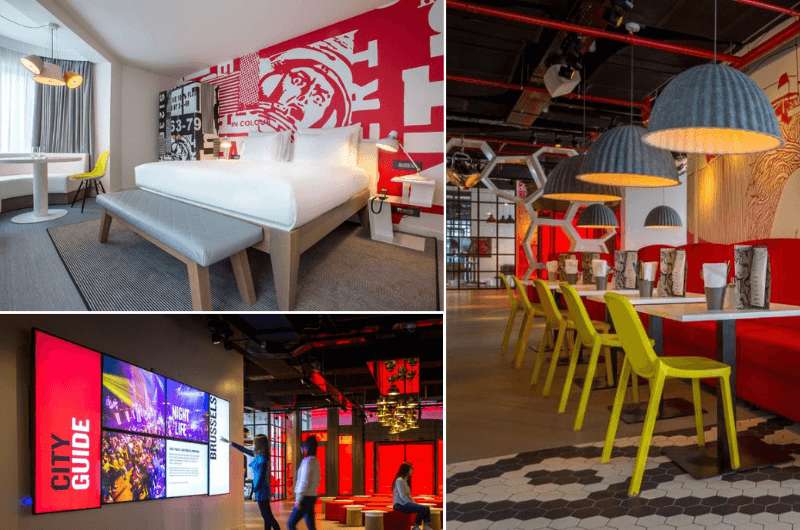

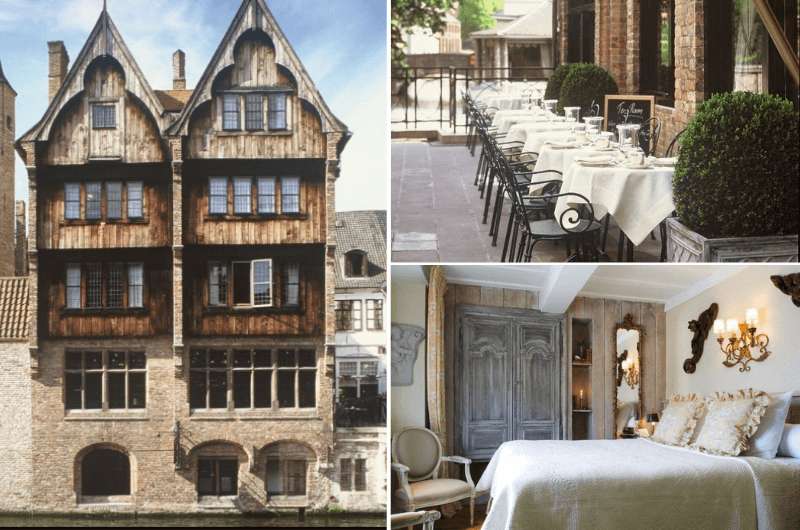
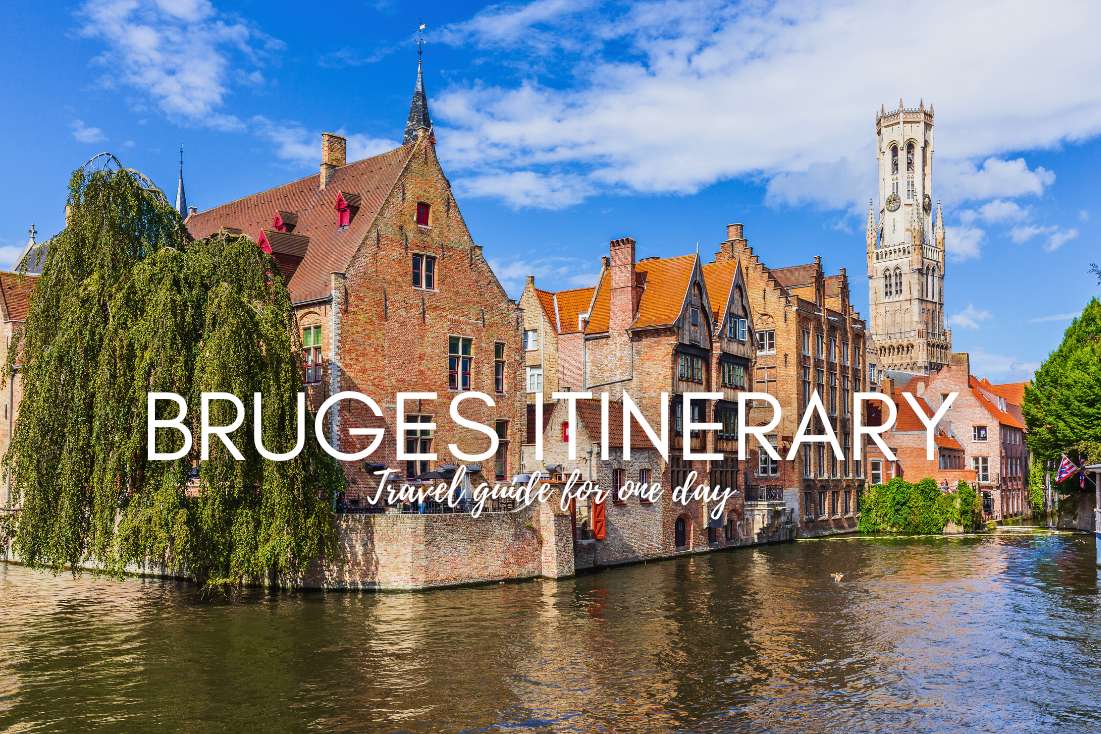
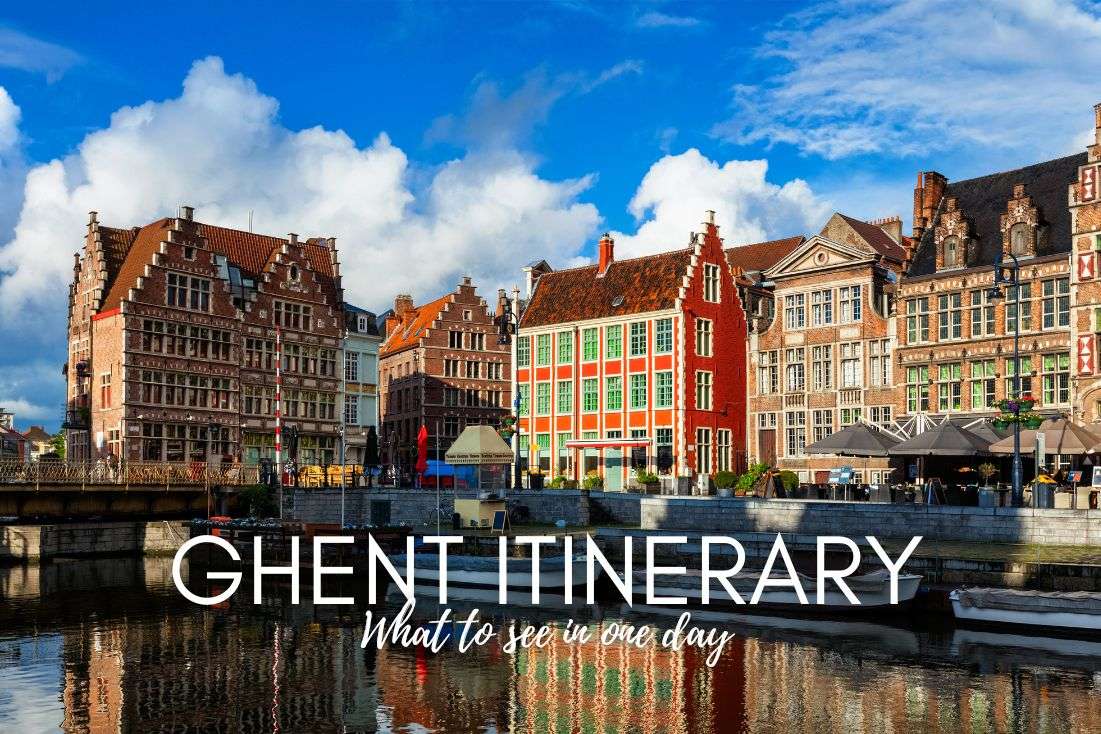
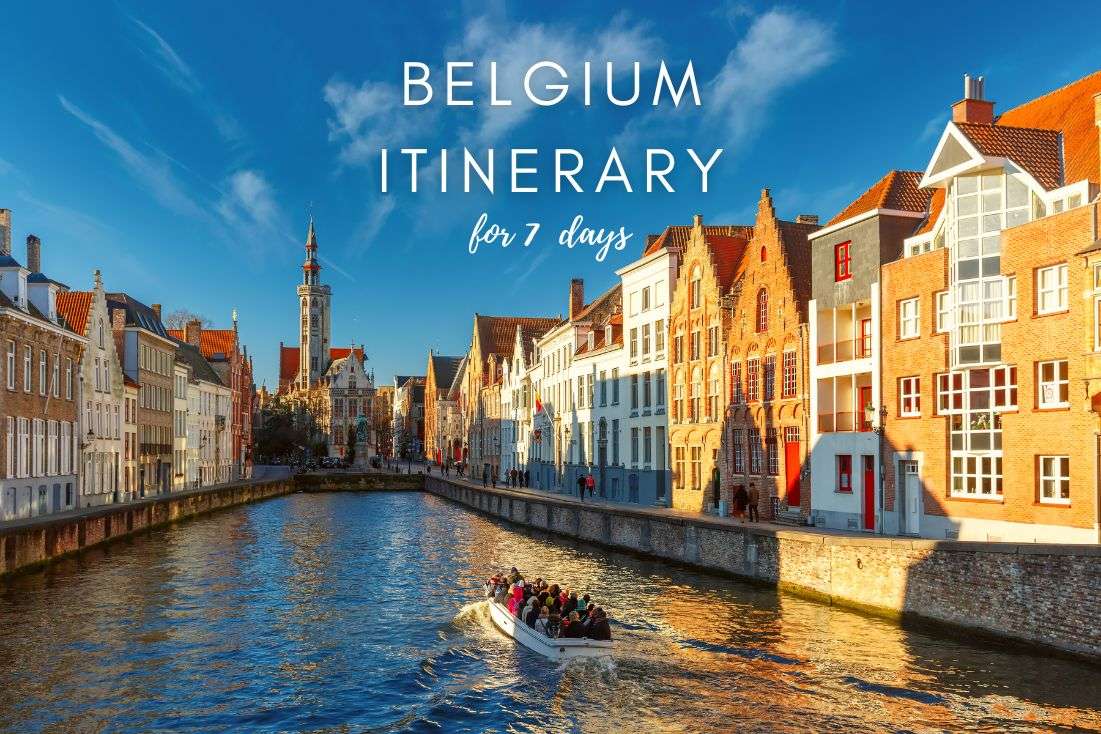





Comments | Thoughts? Give us a shout!